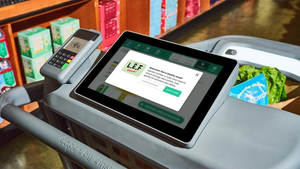STOMACH CRUNCH
Rx-to-OTC switches in the stomach care category bring additional sales, but they can sometimes be hard for food retailers to digest, given restricted shelf space. A potential new entry to watch is the heartburn treatment drug Zegerid, from Shering-Plough Corp., Kenilworth, N.J. The drug maker applied this year to the U.S. Food and Drug Administration for a new drug application for an OTC low-dose
May 12, 2008
JIM KAROLEFSKI
Rx-to-OTC switches in the stomach care category bring additional sales, but they can sometimes be hard for food retailers to digest, given restricted shelf space.

A potential new entry to watch is the heartburn treatment drug Zegerid, from Shering-Plough Corp., Kenilworth, N.J. The drug maker applied this year to the U.S. Food and Drug Administration for a new drug application for an OTC low-dose version.
Perrigo, Allegan, Mich., began shipping Omeprazole, a store-brand heartburn remedy that contains the same medicine at the same dose as Prilosec OTC, the No. 1-selling brand from Procter & Gamble in the antacid tablet category.
New entries such as these put a squeeze on mainstays such as Prilosec, Pepcid and Zantac 150, as well as on standard stomach remedies such as Pepto-Bismol and Tums. As a result, retailers say they continue to evaluate the shelf space for established products of lesser strength to ensure enough facings for the more potent switches. As retailers update their assortments, manufacturers stimulate shoppers' interest with signage and special displays of products that have moved to over-the-counter status.
Meanwhile, befuddled shoppers are seeking the advice of in-store pharmacists to make sense of this dynamic category with its proliferation of stockkeeping units (see “Pharmacists Provide Relief,” next page).
“As various prescription medications change to OTC, there is a definite need to adjust to consumer demands accordingly. Advertising, marketing and manufacturers' incentives to the consumer have produced a tremendous increase in product placement, shelf space and incremental sales in this department,” said Ken Henjum, vice president of pharmacy operations for the PrairieStone pharmacies in 17 supermarkets operated by the Lunds and Byerly's chains, Edina, Minn.
All of the facings in the stomach care category at Spartan Stores are determined by velocity, explained Eddie Garcia, director of pharmacy for the Grand Rapids, Mich.-based company.
“So, whatever product is selling gets more space,” he said. “If a product that was a prescription item goes over-the-counter and all of a sudden takes over the sales of a different item, then that other item loses facings or it's removed altogether. The [shelf] space doesn't increase.” Heartburn medicines are divided into antacids, such as Tums and Rolaids, and acid reducers such as Pepcid and Zantac (H2 inhibitors) and Prilosec (proton pump inhibitors).
The sales performance of these remedies accounts for the scramble for shelf space taking place in supermarkets across the country. Overall, sales for the gastrointestinal tablets category for the 52 weeks ending April 20 were up 1.3% to $1.78 billion, according to Information Resources Inc., Chicago. The data is for total U.S. sales in supermarkets, drug stores and mass-market retailers, excluding Wal-Mart.
Sales of Prilosec OTC, the top-selling antacid tablet, were up 1.7% from a year ago to $384 million, followed by Zantac 150 from Boehringer Ingelheim, the third-highest-selling brand of antacid tablets, up 15.3% to $79.1 million, according to IRI. Private-label products, partly aided by Perrigo's Omeprazole, generated the second-highest sales in the segment, up 13.9% to $150.4 million.
Maria Brous, spokeswoman for Publix Super Markets, Lakeland, Fla., said the main driver for new planograms in the category is Rx-to-OTC switches. Over the past few years, more space has been devoted to these new products, she added, while space allocation for traditional remedies and bulk-fiber products are decreasing.
“Insurance plans are driving more people to the Rx-to-OTC products,” she said. “Greater advertising by manufacturers of these products is also bringing new users to the category.”
All of this activity has placed stress on shelf sets at Tampa, Fla.-based Sweetbay Supermarkets, reported Pam Heath, director of pharmacy. That's because there hasn't been more shelf space even with the additional Rx-to-OTC items.
“We've really had to do some detailed evaluation of what we do carry, to adjust the placements and items of therapy within the spaces allocated,” she said.
Relying on an efficient assortment process, Sweetbay determines which items to carry and how to cut down either on some sizes or flavors to accommodate all of the products in the same amount of space.
“So looking at what sells, we say, ‘We need to carry that, but not in all three sizes.’ And that process hasn't let up in the last year-and-a-half or two, with all the switches that were happening. It's created a lot more work around how we keep the same space, but allocate it for items that people are looking for.”
At Spartan Stores, all the fanfare from the manufacturers with their display shippers when a product goes OTC helps to secure a place on the shelf.
“An expectation of what the sales line will be is pretty much what makes that determination,” said Garcia, who oversees the chain's 63 pharmacies. “We do have a sales history from our pharmacy departments, and we try to convert that to an expectation of what that will mean when it goes over-the-counter. When a prescription is no longer required, in some cases you expand what that potential is, because now there is a market [of consumers] out there that no longer has to go visit their doctor before buying the product.”
When items go over-the-counter, they offer big opportunities for the retailers and for manufacturers, explained Paul Thompson, a consultant in the Dallas office of Henry Rak Consulting Partners, a Chicago-based firm. The key is to plan for the growth and allocate adequate space on the shelf to capture the potential.
“You've got in-store merchandising that's going to take advantage of the marketing effort that goes along with introductions,” he said. “So it's about having endcaps on the floor, for example. Zyrtec was on pallets on the floor in Wal-Mart. And then they had it on Wal-Mart TV. So the retailers understand the impact and the potential that these Rx-to-OTC switches can bring. They really need to maximize this, and they need to maximize it early and often. It's about capturing that benefit initially and getting a fair share of that growth potential as it comes to the OTC market.”
Off-shelf display shippers in supermarkets for these switched products are typical during the first couple of weeks after an Rx-to-OTC launch. Demand increases proportionally to the marketing, advertising and sampling that many drug companies deploy. “The tremendous amount of promotion that the manufacturers do has led to people becoming more aware of these products,” said Garcia of Spartan Stores. “They can save a doctor's visit or maybe get better care than they're currently getting with whatever product that they're using.”
About the Author
You May Also Like




